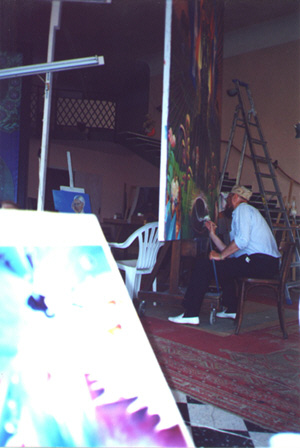
Ernst Fuchs and Fantastic Realism:

Ernst Fuchs painting in his villa in the south of France
(August 2000)
Ernst Fuchs was born in Vienna in 1930. The Nazis force the young Fuchs into a detention camp, and his mother divorces his Jewish father in order to prevent the family's extermination. After surviving the vicissitudes of the Second World War, he began studying art at the Vienna Academy, under the tutelage of Prof. Albert Paris von Gutersloh. It was the Gutersloh's emphasis on the techniques of the Old Masters that gave Fuchs, and other members of the Academy, the kind of solid grounding upon which they could pursue their own masterful work. The students of von Gutersloh comprised the renown Vienna School of Fantastic Realism.
"Psalm 69" egg tempera and oil by Ernst Fuchs (1956-1960)
The Vienna School of Fantastic Realism formed in 1946 included Ernst Fuchs, Rudolph Hausner, Wolfgang Hutter and Fritz Janschka. Arik Brauer and AntonLemden were all visionaries, born of the jagged ruins of post-war Vienna. The group saw itself as surrealist although they were already moving away from the surrealist painting of the 1930s towards a more visionary approach. Technically their work had the clarity and detail of early Flemish Painting. They were quite influential on the continent, but little known or appreciated in Britain.
During the 1950s, Fuchs lived in Paris with artist Friedensreich Hundertwasser. He immersed himself in the classics and absorbed works by Nietzsche, Meyrink, Lao-Tze, and Freud. He later traveled extensively in Israel and the United States.

Fuchs studio in Monaco (works in progress-August 2000)
Oddly, this period in Vienna was
ruled by the frenzy over Abstract Expressionism, and these hard working artists
of the fantastic were given little attention, and what attention was given was
in the form of critical mockery. Fuchs struggled not only to feed his passion
for art, but his stomach, as well.
detail of "Metamorphosis of the Flesh" 1949 (c) copyright Fuchs
In 1957 Hausner fell out with surrealist orthodoxy after completing his first Adam picture and split from Fuchs and the others to pursue his own vision. Fuchs had already moved away from surrealism into Visionary Mannerism. He painted a number of paintings with religious subjects culminating in his triptych The Mysteries of the Holy Rosary for the Catholic church in Hetzendorf, Vienna.

Ernst Fuchs
The Sorrowful Rosary
His paintings from the late 50s to the present day have extraordinary visionary power, Babylonian cherubs, visions of Christ and other mythological subjects explore the roots of middle eastern religious experience. The power of colour, form and content set his work apart from modernism.

In 1970, he began to work on monumental sculptures. Later in 1973, he acquired the Otto Wagner Villa in Vienna, which he subsequently renovated completely and which is now the Ernst Fuchs Museum and contains a complete range of his work to date. He then undertook stage designs for operas, especially Wagner.
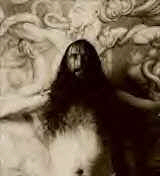
In the 1980s, he had a number of international exhibitions including a retrospective in Venice. In 1993 he had a major retrospective in Russia — one of the first major western artists to do so.
(from Ernst Fuchs Das graphische Werk)
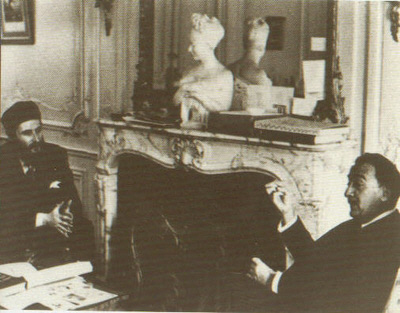
Ernst Fuchs with Salvador Dali in Paris 1968
Ernst Fuchs and Salvador Dali at The Ritz in Barcelona 1974
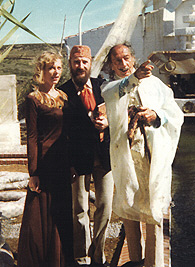
Fuchs with Dali Early 80's (courtesy Ernstfuchs-Zentrum.com)
Salvador Dali, Ernst Fuchs and Arno Breker
As a friend of Dali, Fuchs wandered also in his footsteps in the marketing of his art. Thus, there originated in Austria not only furniture, wallpaper, and objects with Fuchs designs, but also in Germany noble china was produced by Rosenthal, and tiles in white-red-gold for the artistic decoration of bathrooms and living rooms. An artist does not lose anything of his prestige when he creates objects of high value for the daily use. "It corresponds to my understanding of democracy, to enable many people to enjoy beautiful things," says the Master. In this effort, Fuchs has created also sculptures such as "Justitia," "Daphne," or "The Sphinx." To his large bronzes belongs a monumental, full-breasted "Esther." She adorns the hood of Dali's car in his museum in the Spanish town of Figueras. At the unveiling of this biblical personage the "divine Dali" praised it like the King Salomon: "Her breasts are like wells. I thirst for the milk of knowledge."
Courtyard of the Teatro-Museo Dali, Figueras August 12, 1975
The Venus of Fire, a renowned music hall dancer in Barcelona, poses on the Rainy Taxi from the Surrealist exhibition of 1938. In front is Queen Esther, a bronze statue given to the museum by the Austrian sculptor and painter Ernst Fuchs.
Patio of the Teatro-Museo Dali, Figueras 1983
In the foreground Queen Esther, a statue donated by Ernst Fuchs, serves as a monumental radiator cap on the Cadillac.
(from Ernst Fuchs Das graphische Werk)
Perhaps more than any other contemporary artist, Fuchs has had a widespread and profound influence on many artists of the fantastic. H.R. Giger, Robert Venosa, Mati Klarwein, Mark Ryden, De Es Schwertberger and others all count him as a key teacher or inspirational force, both as an artist and as a personage.

Fuchs with Roybal (Payerbach, Austria-July 2000)
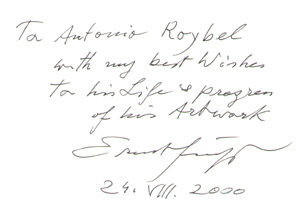
Visit these Ernst Fuchs official sites:
http://www.ernstfuchs-zentrum.com/
Ernst Fuchs, Salvador Dali, Ernst Fuchs, Fantastic Realism, Visionary Surreal, Dali Fuchs, Fuchs Dali, Art, Ernst Fuchs, Salvador Dali, Jean Claude Gaugy, Robert Venosa, Santa Fe paintings, Surreal, Surrealist, michael fuchs, Salvador Dali, Ernst Fuchs, Fantastic Realism, Visionary Art, Visionary Artist, Ernst Fuchs, Salvador Dali, Jean Claude Gaugy, Robert Venosa, Martina Hoffman, Namingha, Santa Fe paintings, Neo Classical Symbolism, Visionary Mannerism, Surreal, Surrealist, michael fuchs, Salvador Dali, Ernst Fuchs, Fantastic Realism, Visionary Art, Ernst Fuchs, Salvador Dali, Jean Claude Gaugy, Robert Venosa, Namingha, Santa Fe paintings, RC Gorman, Georges Mazilu, Pietro Annigoni, Todd Schorr, Vincent Desiderio, De Es, Gustav Moreau, Jean Delville, Surreal, Surrealist, michael fuchs, Odd Nerdrum, Esoteric Art, Ernst Fuchs, Fantastic Realism, Surreal Paintings, Ernst Fuchs, Surreal, Surrealist, Odd Nerdrum, Mark Ryden, Gustav Klimt, Egon Schiele, Hundertwasser, Moreau, El Greco, Magic Realism, Magic Mannerism, Di Maccio, Giger, Renaissance painting, Renaissance paintings, Van Eyck, Hieronymus Bosch, Van der Weyden, Egg tempera, mische technique, Visionary Art, Visionary Art, Visionary Art, Old Master, Rudolph Hausner, Brauer, Fantastic art links, Fantastic art links, Visionary, Fantastic, Surreal art links, Santa Fe Gallery, Ernst Fuchs, Ernst Fuchs, Ernst Fuchs, Gustav Klimt, Gil Bruvel, Jean Auguste Dominique Ingres, Holbein, Durer, Vermer, Georges Mazilu, Alfredo Castaneda, Dieric Bouts